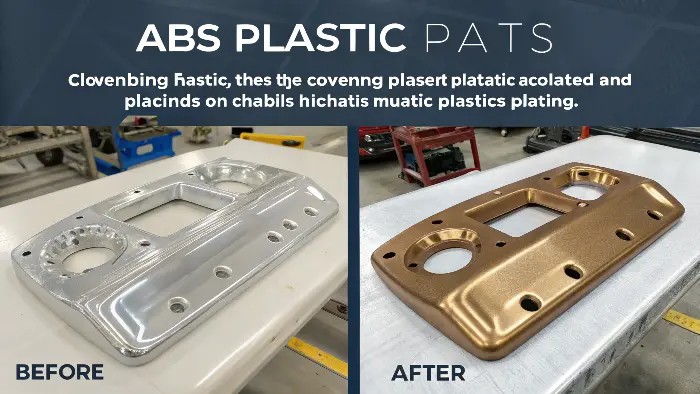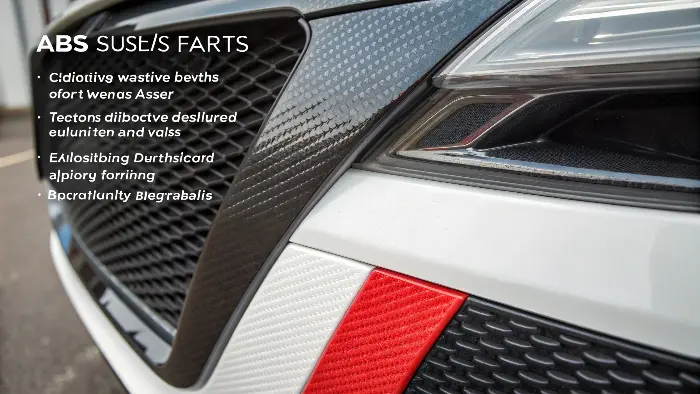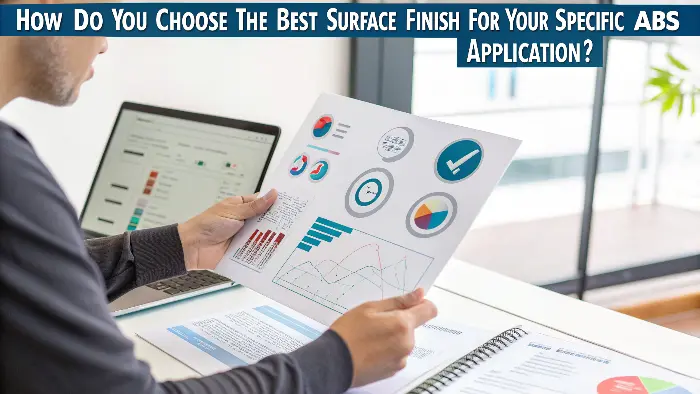Struggling to make your ABS parts stand out? Ordinary finishes can make products look cheap and feel underwhelming, impacting customer perception and sales. It’s a common headache for many businesses I’ve worked with.
Second paragraph at the beginning, answering the question posed by the title, this paragraph must be HELPFUL to the reader and will be used later to compete for Google’s Featured Snippets. (max 60 words)
Elevate your ABS injection molded parts through painting for custom colors, plating for a metallic look and enhanced durability, or texturing for improved grip and aesthetics. These techniques significantly boost product appeal and functionality, meeting diverse market demands effectively.
When you’re looking at a freshly molded ABS part, it’s like a blank canvas. It’s functional, sure, but does it pop? Does it feel like a premium product in your customer’s hand? Probably not without a little help. That’s where surface finishing comes in. It’s not just about looks; it’s about performance, durability, and the overall user experience. I’ve seen firsthand how the right finish can transform a good product into a great one. So, let’s explore some of the most effective ways to take your ABS parts to the next level. You’ll want to understand these options to make the best choices for your projects.
Is Painting the Right Choice for Adding Color and Protection to Your ABS Parts?
Plain ABS parts lacking visual appeal? Unprotected surfaces can scratch easily, diminishing your product’s lifespan and perceived value, which is a big concern for businesses like yours, Michael.
Painting offers a versatile solution for ABS parts, providing a wide color spectrum, brand consistency, and a protective layer against wear and UV degradation. It’s an effective way to enhance aesthetics and durability, often being the go-to for many consumer electronics.
Painting is often the first thing people think of when they want to add color or a specific look to plastic parts. And for good reason! It’s incredibly versatile. You can achieve almost any color imaginable, match brand-specific Pantone shades, and apply different gloss levels – from matte to high gloss. For someone like Michael, who’s in consumer electronics, consistent branding and a premium look are super important. I remember a project for a client making high-end audio equipment; the specific satin black finish we achieved through painting was a key selling point.
But it’s not just about looks. A good paint job adds a layer of protection. ABS is pretty tough, but paint can shield it from scratches, scuffs, and even UV radiation, which can degrade plastic over time. Think about products that are handled a lot or exposed to sunlight.
The process itself involves a few key steps. First, surface preparation is critical – you can’t just slap paint on raw plastic. The parts need to be cleaned thoroughly to remove any oils, dust, or mold release agents. Sometimes, a primer is needed to ensure good adhesion. Then, the paint is applied, usually by spraying for a uniform coat. We often use robotic arms for this in larger production runs to ensure consistency. After painting, the parts need to be cured, often in an oven, to harden the paint. Common paint types include acrylics for general use, polyurethanes for higher durability, and epoxies for chemical resistance. Choosing the right one depends heavily on the product’s end-use. It’s a bit more involved than it sounds, but the results can be fantastic.
Could Plating Give Your ABS Parts That Premium Metallic Sheen and Toughness?
Want a high-end metallic look without the cost and weight of actual metal? Plastic parts can sometimes feel less robust than desired, which might not align with the premium image you’re aiming for.
Plating ABS parts, often with chrome, nickel, or copper, creates a durable, corrosion-resistant metallic finish. This process significantly enhances visual appeal, perceived value, and even adds a bit of structural integrity for a premium product feel.

Now, if you’re looking for that shiny, metallic look – think car grilles, bathroom fixtures, or high-end electronic accents – then plating is your friend. It’s a process that deposits a thin layer of metal onto the ABS surface. The most common one you hear about is chrome plating, but nickel, copper, gold, and silver are also options, though some are pricier than others, naturally. I find that for many of my clients, like Michael, who want to give their consumer electronics a more luxurious or durable feel, plating is a serious contender.
The cool thing about plating plastics is you get the aesthetic and some of the properties of metal (like hardness and wear resistance) without the weight or cost of a solid metal part. It can really elevate the perceived value. I had a client who switched from painted silver to actual chrome plating for a small decorative trim on their product, and customer feedback on the "premium feel" shot up. It also provides excellent corrosion resistance and can even offer EMI/RFI shielding, which is a big plus for electronics.
The process, though, is quite a bit more complex than painting. Because plastic isn’t conductive, you can’t directly electroplate it. So, it involves a multi-stage chemical process. First, the ABS is etched to create microscopic pores for adhesion. Then, it goes through neutralization, activation (with something like palladium), and an electroless plating step (usually nickel or copper) to create an initial conductive layer. Once that’s on, the part can be electroplated with the final metal layer like chrome. It’s a bit of a science, and getting it right consistently, especially adhesion, is key. It also requires careful handling of chemicals, so environmental considerations are important here.
How Can Texturing Transform the Look, Feel, and Functionality of ABS Components?
Are your ABS parts too smooth, leading to poor grip or a generic appearance? Fingerprints and minor scuffs can also be a real nuisance, making products look used quickly.
Texturing ABS parts, often directly in the mold, creates various surface patterns. This improves grip, hides minor imperfections like sink marks or flow lines, and enhances visual appeal. It offers a cost-effective way to differentiate products and improve the overall user experience.

Texturing is a fantastic way to add character and functionality to ABS parts, and it’s often done directly in the mold, which is super efficient for mass production. Instead of a smooth, glossy surface, you can have anything from a subtle matte finish to a deep leather-like grain, or even geometric patterns. For Michael, this could mean better grip for handheld devices or a more sophisticated, less "plasticky" look for enclosures. One of the big advantages I always point out to clients is that textures are great at hiding minor cosmetic flaws – small sink marks, flow lines, or even fingerprints become much less noticeable. This can improve your yield rates for visually critical parts.
There are a few ways to get texture onto a mold. Chemical etching is very common, where acid is used to selectively eat away at the mold surface to create the pattern. Laser texturing is a more modern, precise method that can create very complex and fine patterns. EDM (Electrical Discharge Machining) can also be used for certain types of textures, especially those with a rougher, spark-eroded look. We often work with standard texture charts, like VDI (from Germany) or Mold-Tech (MT) here in the US, so clients can pick a specific texture and know what they’re getting.
The choice of texture isn’t just about looks, though. It affects how the part feels in the hand – a slightly roughened texture can feel warmer or more secure than a slick, smooth one. It can also impact mold release; sometimes a slight texture helps parts eject more easily. Deeper textures might require more draft angle on the part design to prevent drag marks. It’s a detail, but an important one we always discuss during the DFM (Design for Manufacturability) stage. I remember a project where we added a very light texture to an internal component just to make it easier for assembly line workers to handle – a small change with a good impact!
What If You Need More Than One Finish for Your ABS Masterpiece?
Facing a complex project where a single finish just isn’t enough to meet all your design goals? Juggling different aesthetic, functional, and even branding needs for a single part can be quite tricky.
Combining surface finishes, like texturing with selective painting or plating specific areas after molding, offers maximum design flexibility for ABS parts. This approach allows for tailored aesthetics, enhanced functionality, and truly unique product differentiation, making your product stand out.

Sometimes, one finish alone won’t cut it. You might need the grip of a texture in one area, the vibrant color of paint in another, and maybe a shiny plated logo to top it off. This is where things get really interesting and where you can create some truly standout products. I’ve worked on many projects where we combined finishes to achieve a specific design intent. For instance, Michael might have a consumer electronic device with a textured main body for good grip and a premium feel, but a high-gloss painted front panel for a sleek display area, and perhaps a small, plated brand emblem.
Combining finishes requires careful planning. Masking is a big one – if you’re painting a textured part, you need to make sure the paint only goes where you want it. Or if you’re plating a specific section, the rest of the part needs to be protected. Adhesion between layers is also crucial. For example, some paints might not stick well to certain plated surfaces, or a textured surface might need a special primer before painting. The order of operations matters too. Usually, texturing is done in the mold, and then painting or plating happens as secondary operations.
Think about a car interior – you often see textured plastics, painted accents, and chrome details all working together. It’s all about creating a cohesive and high-quality experience. We once helped a client develop a remote control that had a soft-touch painted main body (for a nice feel), a textured back for grip, and a few small, brightly plated buttons for easy identification. It was more complex to manufacture, sure, but the end result was a product that felt and looked much more expensive than its competitors. This kind of detail can be a real differentiator in a crowded market. So yeah, don’t be afraid to mix and match – it just requires a bit more thought upfront.
How Do You Choose the Best Surface Finish for Your Specific ABS Application?
Overwhelmed by the sheer number of finishing options for your ABS parts? Making the wrong choice can lead to costly rework, project delays, or a final product that just doesn’t hit the mark.
Select the best ABS surface finish by carefully considering your product’s end-use, desired aesthetics, durability requirements (like scratch or UV resistance), your budget, and expected production volume. A methodical evaluation ensures optimal performance and visual appeal for your components.

| Alright, so we’ve talked about painting, plating, texturing, and even combining them. How do you, as a business owner like Michael, actually decide what’s best for your ABS parts? It’s not always a straightforward answer, as it depends on a bunch of factors. I always tell my clients to think about a few key things. First, what’s the end-use of the product? Is it going to be handled frequently, exposed to sunlight, or chemicals? This will heavily influence durability requirements. Second, what’s the desired aesthetic? Are you going for a vibrant color, a metallic sheen, a subtle matte look, or a specific tactile feel? Your brand identity plays a role here too. Budget is, of course, a huge factor. In-mold texturing is generally the most cost-effective on a per-part basis once the mold is made, while multi-step processes like plating can be more expensive. Production volume also matters. For high volumes, investing in a textured mold makes a lot of sense. For smaller runs, painting might be more flexible. To help make this a bit clearer, here’s a quick comparison. Think of it as a cheat sheet: |
Feature | Painting | Plating | Texturing (In-Mold) |
|---|---|---|---|---|
| Aesthetics | Wide color range, various gloss levels | Metallic look (chrome, nickel, etc.), high gloss | Patterns, matte/gloss, hides imperfections | |
| Durability | Good (UV, scratch resistance varies by paint type) | Excellent (wear, corrosion resistance) | Good (hides wear, part inherently durable) | |
| Tactile Feel | Smooth (can be soft-touch) | Smooth, cool (metal-like) | Varies (grippy, smooth, patterned) | |
| Cost (Per Part) | Moderate | High | Low (after initial mold cost) | |
| Complexity | Moderate (surface prep, application, curing) | High (multi-stage chemical process) | Low (part of molding process) | |
| Lead Time | Adds post-processing time | Adds significant post-processing time | Minimal (integrated with molding) | |
| Typical Uses | Housings, covers, branding | Decorative trim, luxury feel, EMI shielding | Handles, enclosures, functional surfaces |
I remember a client who was developing a new handheld scanner. They initially wanted it fully chrome-plated for a "high-tech" look. But after we discussed the daily rough handling it would get and their budget, we shifted to a robust dark gray textured ABS for the main body (for grip and durability) and a smaller, selectively painted silver accent. It saved them money and resulted in a more practical, yet still professional-looking, product. So, it’s about balancing all these factors. My advice? Talk to your manufacturing partner early in the design process. We can help you weigh the pros and cons.
Conclusion
Choosing the right surface finish—painting, plating, or texturing—can dramatically enhance your ABS parts’ appeal and function. Consider your product’s needs, aesthetics, and budget to make the best decision for success. It’s an investment that pays off.
